Key takeaways:
- Formative assessments foster a supportive learning environment by providing ongoing feedback and encouraging open dialogue between students and instructors.
- Summative assessments serve as a final measure of student learning, often highlighting both strengths and areas for improvement, but can also create pressure and anxiety among students.
- The contrast between formative and summative assessments impacts student motivation, with formative assessments promoting a growth mindset while summative assessments may discourage some learners.
- Personal experiences with both types of assessments reveal their respective benefits; formative assessments can enhance engagement and confidence, while summative assessments offer valuable insights for curriculum adjustments.
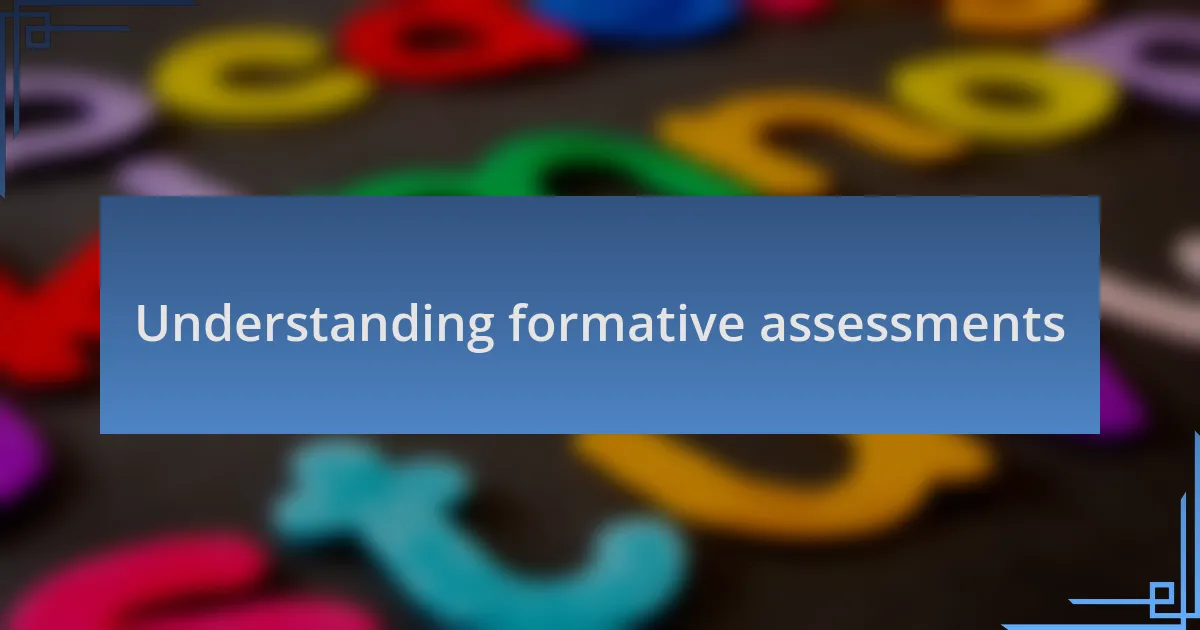
Understanding formative assessments
Formative assessments are tools designed to monitor student learning and provide ongoing feedback that can be used by instructors to improve their teaching and by students to enhance their learning. I remember the first time I introduced an informal quiz during a training session. The relief on my learners’ faces when they realized it was just a way to gauge their understanding, not a final judgment, was palpable. It shifted the atmosphere from pressure to partnership, encouraging a more open dialogue about their struggles.
The beauty of formative assessments lies in their adaptability. They can take many forms—even a simple thumbs-up or thumbs-down can reveal how confident a student feels about a topic. Isn’t it fascinating how such a small gesture can spark conversations that lead to deeper understanding? When I ran a workshop focused on dyslexia, these quick check-ins led to revelations about individual challenges and tailored support that I couldn’t have achieved through traditional means.
These assessments are not just about collecting data; they are strategic opportunities to shape learning experiences. As I reflect on my experiences, I recall a specific instance where feedback from a simple observation checklist guided me to adjust my teaching methods dramatically. Have you ever had an unexpected insight that changed your approach? Those moments remind us that learning is a dynamic journey—not a destination.
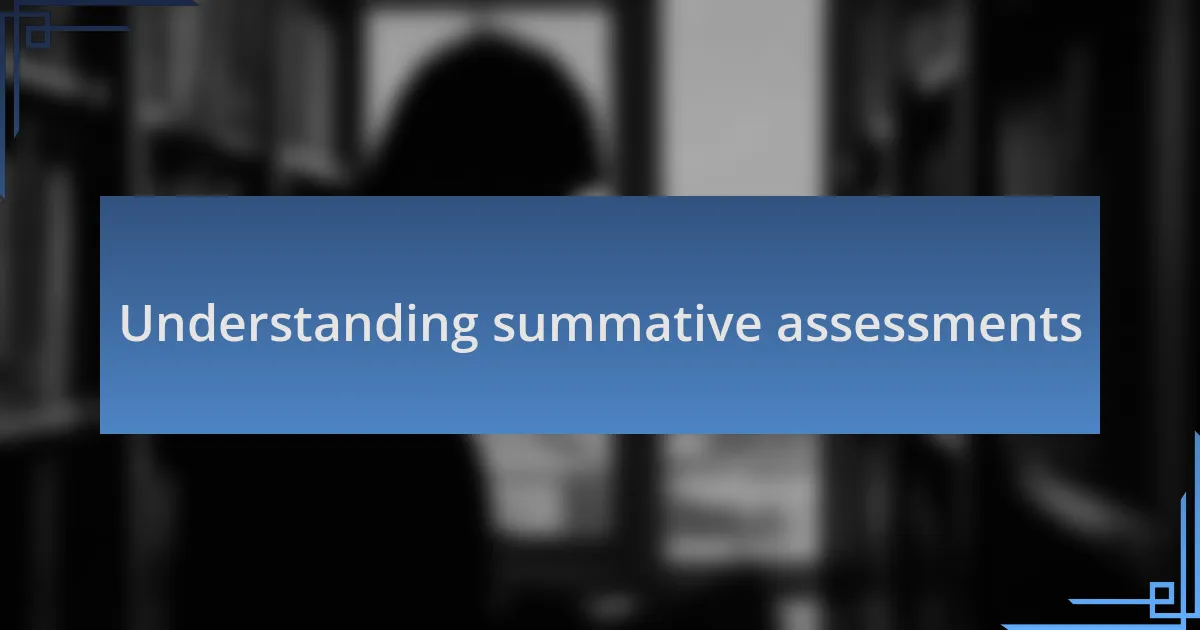
Understanding summative assessments
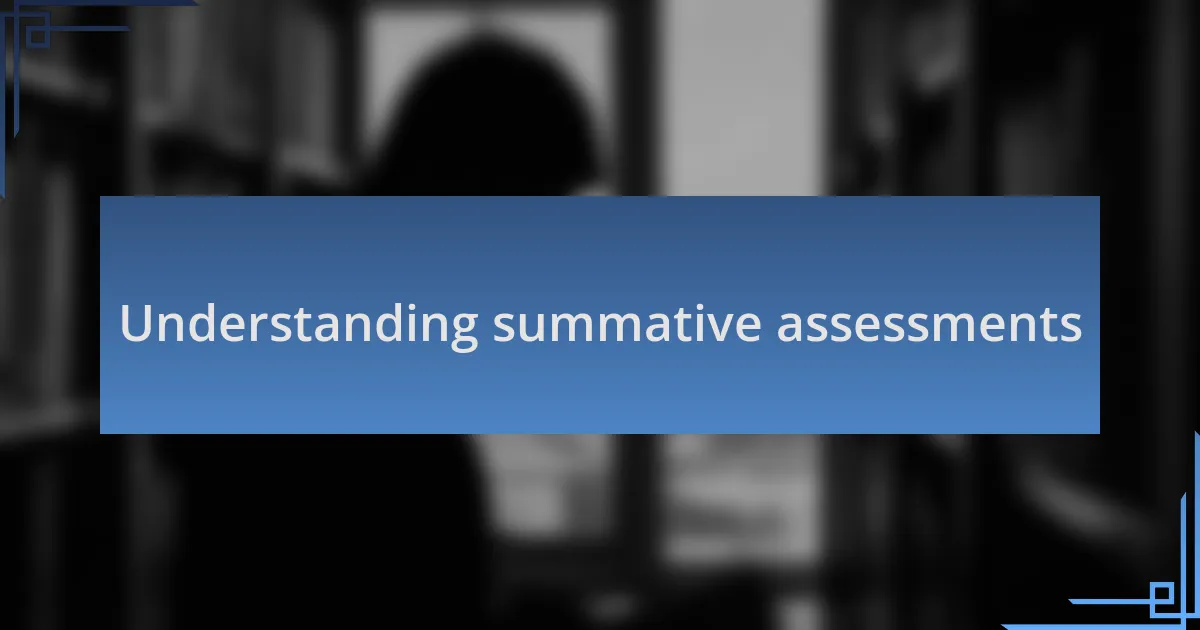
Understanding summative assessments
Summative assessments serve as a tool to evaluate student learning at the end of an instructional period. I can still recall the tension in the room during a final exam—students hunched over their desks, pencils poised. It struck me how these moments often measure not just knowledge, but anxiety, too. Isn’t it interesting how the stakes can change the learning experience?
Unlike formative assessments, which offer continuous feedback, summative assessments provide a final snapshot of understanding. I once administered a comprehensive test after a lengthy unit on reading strategies for dyslexic learners. The sense of finality felt heavy, but it also illuminated which concepts resonated and which needed readdressing. This contrast drives home the point—summative assessments are crucial, yet they reveal only part of the learning story.
These assessments can, unfortunately, discourage students who struggle, often labeling them based on performance rather than progress. I remember a student who excelled in discussions but bombed the final project. Witnessing his disappointment made me reflect on the broader implications of using a single assessment to define success. How do we balance the need for standard measures with the unique journeys of each learner?
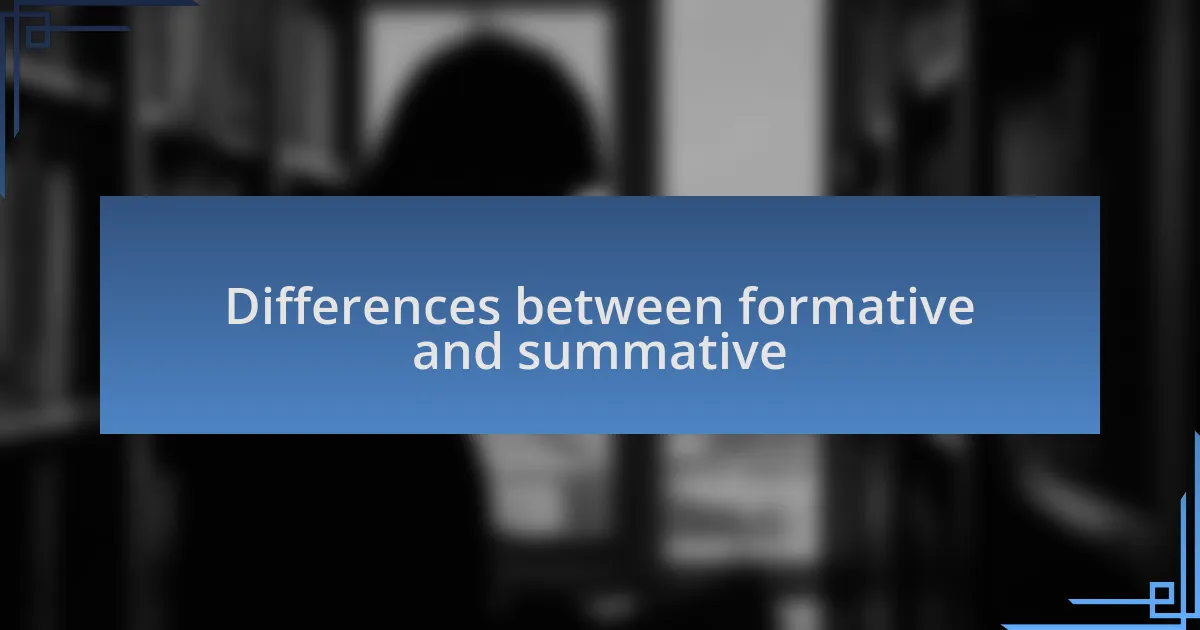
Differences between formative and summative
When we dive into the differences between formative and summative assessments, the contrast becomes quite apparent. Formative assessments are like a guiding hand throughout the learning process, offering ongoing feedback and helping students to adapt and grow. I remember a time when I used quick check-ins, such as pulse checks or verbal reflections, to gauge understanding during a reading lesson. Those moment-to-moment insights fueled my instructional choices and created a supportive environment where learners felt their voices mattered.
On the flip side, summative assessments are often seen as a final judgement—a culmination of all that has been learned. There’s a certain weight to them that can be overwhelming. I vividly recall the anxiety bubbling up among my students as we approached the end-of-unit exam. That tension made me wonder: are we truly capturing the essence of their learning through this high-pressure moment, or just a snapshot of how they perform under stress?
Finally, it’s essential to note how these types of assessments impact student motivation differently. While formative assessments can encourage a growth mindset, promoting resilience and continuous improvement, summative assessments might inadvertently lead some students to feel defeated. I once had a bright student who thrived in casual discussions but faltered during the final evaluation. His struggle brought to light the importance of viewing assessments through a broader lens—what if we recognized progress and efforts more than just a final score?
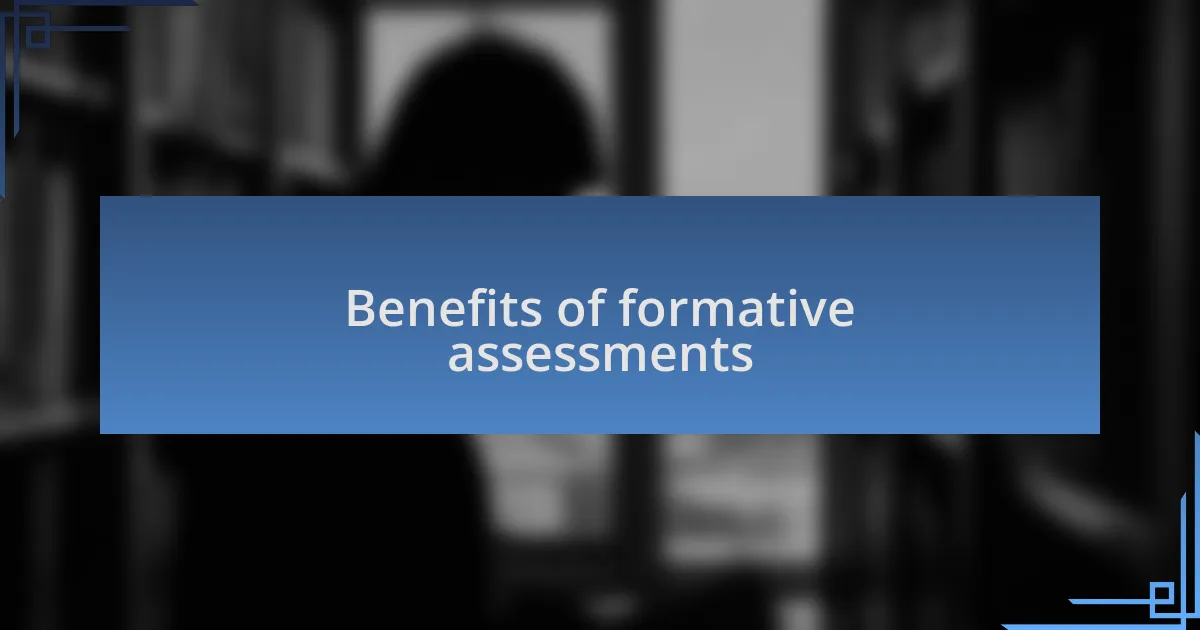
Benefits of formative assessments
Formative assessments offer a treasure trove of insights that can significantly enhance the learning experience. For example, I once organized small group discussions during a literacy unit. These informal assessments provided me with a real-time understanding of my students’ challenges. It was amazing to see how much more engaged they became when they knew I was tuning into their needs. Isn’t it refreshing to think about learning as a collaborative journey rather than a series of isolated tests?
Moreover, these ongoing evaluations foster a culture of open communication. I distinctly remember having a student who struggled with reading comprehension. Through consistent check-ins, we discussed her thoughts and feelings about the texts, allowing me to tailor my support. This approach helped her feel empowered and understood. Can you recall a time when someone truly listened to your concerns? That sense of validation can inspire learners to take ownership of their progress.
I’ve also noticed that formative assessments build confidence over time. By celebrating small victories—like mastering a new word or grasping a concept—students can see their growth incrementally. I often share these wins publicly in class, which not only boosts individual morale but also reinforces a supportive classroom community. Isn’t it incredible how acknowledging progress can reshape a student’s entire outlook on learning?
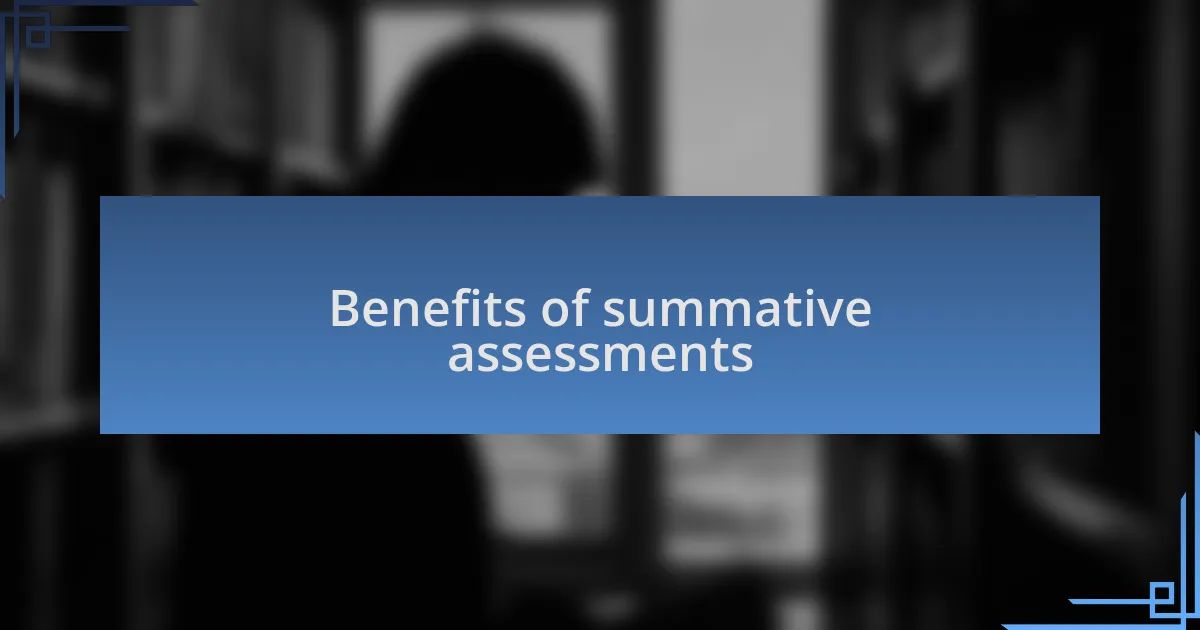
Benefits of summative assessments
Summative assessments serve as a valuable snapshot of student learning at a specific point in time. I recall a moment when I administered a final project that encapsulated weeks of hard work. The sense of accomplishment was palpable among students, providing them with a feeling of closure and a tangible measure of their skills. Have you noticed how such assessments can celebrate learning milestones?
Additionally, these assessments provide essential data that can guide curriculum adjustments. After one semester, I reviewed the test results from a comprehensive assessment, and it highlighted areas where students excelled and where they struggled. This data-driven approach allowed me to refine the curriculum to better meet the needs of my students. It’s fascinating how reflection on results can fuel growth, don’t you think?
Moreover, summative assessments can benchmark student performance against broader standards. I’ve participated in discussions where we compared our results against other districts, illuminating trends in learning that transcended my classroom. This kind of analysis often sparks a spirit of collaboration among educators as we seek to elevate our teaching strategies. How often do we harness the power of collaboration to drive meaningful change in education?
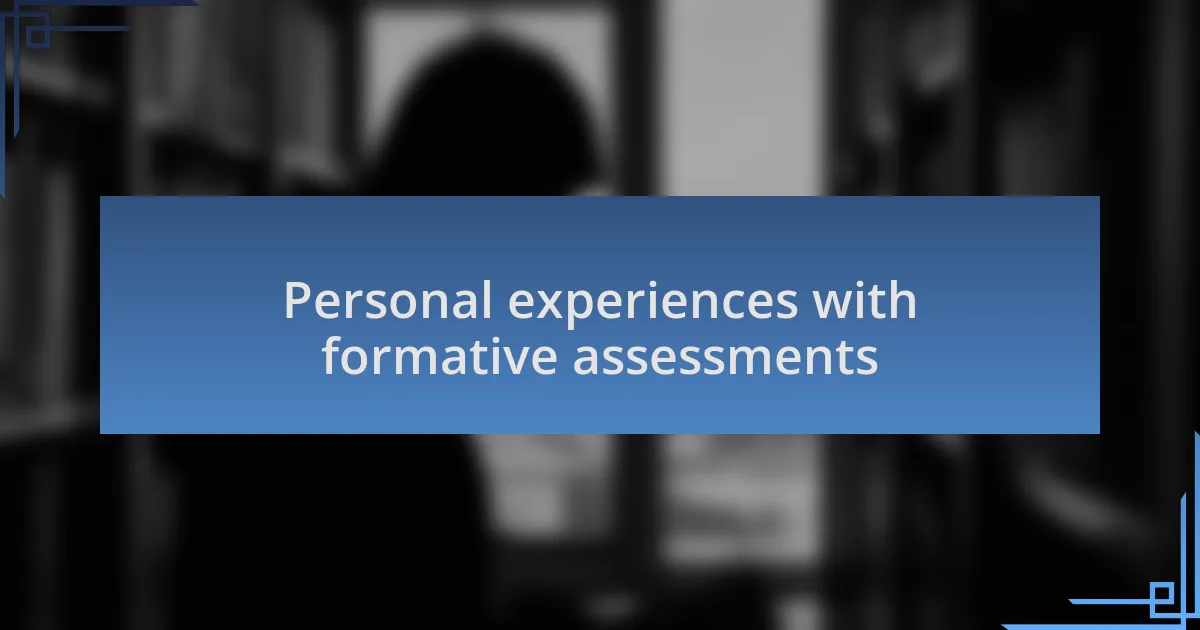
Personal experiences with formative assessments
Formative assessments have a unique place in my teaching journey. I vividly remember introducing quick check-ins, like exit tickets, at the end of my lessons. It was rewarding to see students express their understanding through simple questions, allowing me to adjust my teaching on the fly. Don’t you find it incredible how a few moments of reflection can steer the entire course of learning?
Another memorable experience involved a group project where students were required to peer-assess one another’s contributions. It was fascinating to witness their discussions about feedback; they often provided insights that I hadn’t even considered. This made me realize that collaboration among students can lead to deeper understanding. Have you ever witnessed how students learn from each other in ways we can’t always anticipate?
One of the more poignant moments I experienced with formative assessments came during a reading workshop for students with dyslexia. I offered ongoing check-ins to gauge their comprehension, and the growth I saw was astounding. Their progress wasn’t just about grades; it was about self-confidence blooming in real-time. Isn’t it powerful when students start to believe in their abilities through continuous, supportive assessments?

Lessons learned from summative assessments
Summative assessments have often provided a crucial snapshot of student learning at the end of a unit, revealing patterns I might not have noticed. I recall a particular end-of-term exam for a group of students with dyslexia that not only highlighted their struggles with certain concepts but also illuminated their strengths. This dual perspective allowed me to celebrate their victories while addressing areas needing improvement. Isn’t it fascinating how one test can open a window to a broader understanding of a learner’s capabilities?
When I first encountered the results of standardized tests, I felt a mixed wave of emotions. On one hand, there was the data showing where my students excelled, but on the other, I noticed gaps that our formative efforts hadn’t fully uncovered. This realization pushed me to reconsider the balance of my teaching strategies; I began to look at summative assessments not just as final evaluations, but as vital feedback loops that guided my future lessons. Have you ever experienced that moment when numbers on a page prompt a reevaluation of your entire approach?
I vividly remember administering a project-based summative assessment that involved creating a presentation on a topic related to dyslexia. The students’ engagement levels soared as they shared their insights and personal stories. It struck me how these presentations not only assessed their knowledge but also fostered a supportive environment where students could empathize with one another’s experiences. Could it be true that summative assessments, when designed thoughtfully, can transform the learning experience into something far more profound?